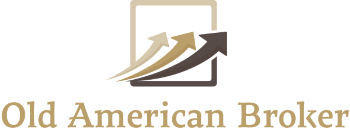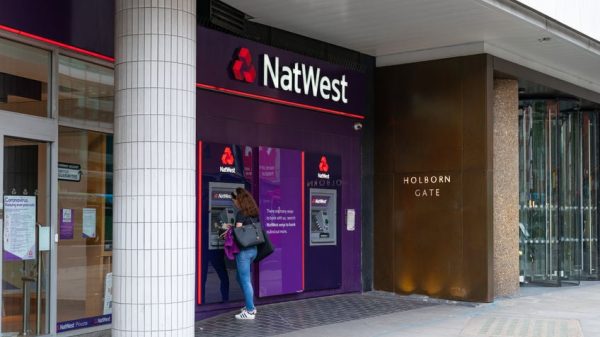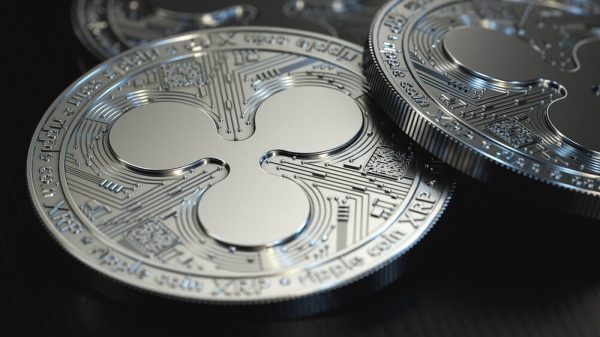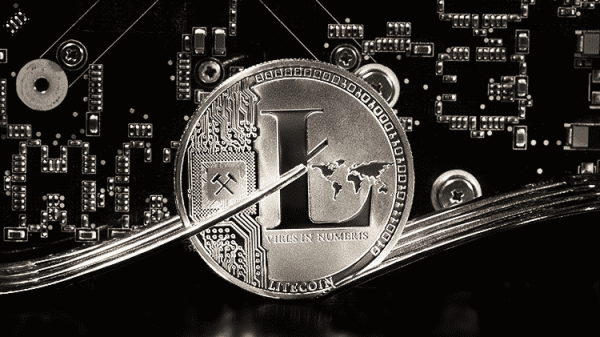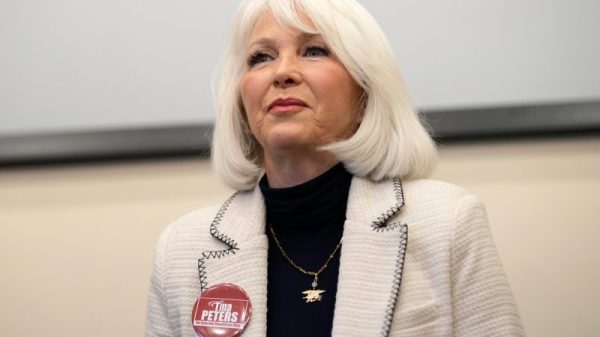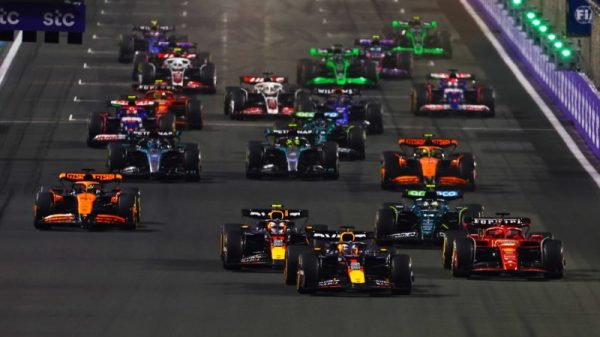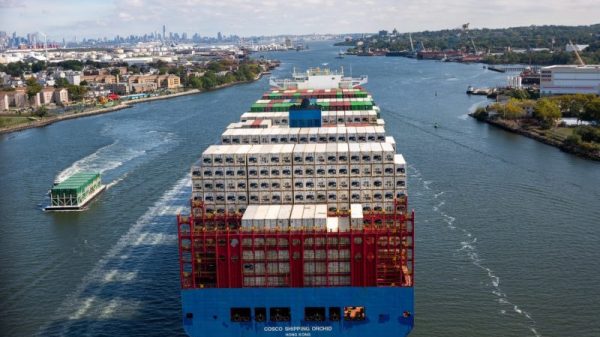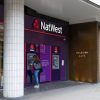
AngioDynamics (ticker: NASDAQ:ANGO), a leading provider of medical, surgical, and diagnostic devices, reported a slight increase in revenue for the first quarter of fiscal year 2025, achieving a 1.1% year-over-year growth with total worldwide revenue reaching $67.5 million.
The company’s MedTech segment, which includes Auryon and AlphaVac products, experienced a nearly 9% increase in revenue, contributing to the overall positive performance. Despite a decline in the Med Device segment by 4%, the company remains optimistic about its operational initiatives and market momentum. AngioDynamics also highlighted its transition to outsourced manufacturing, which is expected to yield significant cost savings by fiscal 2027.
Key Takeaways
- Total worldwide revenue of $67.5 million, marking a 1.1% year-over-year increase.
- MedTech segment revenue up by nearly 9%, with Auryon and AlphaVac products growing over 20%.
- Adjusted EBITDA loss minimized to $200,000, improving from a $1.1 million loss in the previous fiscal year.
- Auryon revenue grew by 25%, benefiting from new product launches and entry into the European market.
- AlphaVac showed substantial interest after FDA clearance and CE marking, with AngioVac revenue stabilizing at $5.8 million.
- NanoKnife revenue declined by 6.9% due to a strong prior year comparison, despite positive adoption trends among urologists.
- Med Device segment revenue down by 4%, with the company expecting to meet its full-year guidance of 1% to 3% growth.
- Transition to outsourced manufacturing anticipated to save $15 million annually by fiscal 2027.
- Reaffirmed revenue guidance for fiscal year 2025 between $282 million and $288 million.
- Stock repurchase program initiated, with $500,000 of shares bought back at an average price of $7.62.
Company Outlook
- Full-year guidance of 1% to 3% growth in the Med Device segment.
- Revenue guidance for fiscal year 2025 reaffirmed at $282 million to $288 million.
- Adjusted EBITDA projected to range from a loss of $2.5 million to break-even.
- Plans to expand Auryon platform in hospitals and introduce new product enhancements.
- Anticipated cost savings from manufacturing transition to improve gross margins.
- Expectation for cash flow positivity by fiscal year 2026.
Bearish Highlights
- Med Device segment revenue declined by 4%.
- Adjusted net loss of $4.4 million ($0.11 per share), although an improvement from the previous year.
- Cash and cash equivalents decreased to $55 million from $76.1 million at the end of May 2024.
Bullish Highlights
- MedTech segment and products like Auryon and AlphaVac driving revenue growth.
- Optimism about ongoing operational initiatives and market momentum.
- Transition to outsourced manufacturing expected to generate significant savings.
- Positive feedback from recent events for AngioVac, indicating a market shift to mechanical interventions.
Misses
- NanoKnife revenue declined by 6.9% due to strong prior year performance.
- Gross margin slightly down from the previous year due to inflation and increased hardware depreciation.
Q&A Highlights
- International Med Device revenue deferral to Q2 due to distributor order timing.
- Expectation for smoother international order timing for products like NanoKnife.
- Plans for new product launches, regulatory approvals, and geographic expansions in 2024.
AngioDynamics’ management team, including CEO Jim Clemmer and CFO Steve Trowbridge, expressed confidence in the company’s strategy and product pipeline. The MedTech segment’s growth, coupled with a robust plan for expansion and cost-saving initiatives, positions the company for potential future success amidst a challenging market environment. With a focus on innovation and efficiency, AngioDynamics aims to capitalize on the growing demand for its products and enhance its market presence both domestically and internationally.
InvestingPro Insights
AngioDynamics’ recent financial performance aligns with several key metrics and insights provided by InvestingPro. The company’s market capitalization stands at $256.4 million, reflecting its position in the medical device industry. Despite the reported revenue growth in the MedTech segment, InvestingPro data shows a revenue decline of 10.28% over the last twelve months, with Q4 2024 seeing a more significant drop of 22.06%. This aligns with the challenges faced in the Med Device segment mentioned in the article.
An InvestingPro Tip highlights that AngioDynamics holds more cash than debt on its balance sheet, which is crucial given the company’s current focus on operational initiatives and transition to outsourced manufacturing. This strong liquidity position is further supported by another tip indicating that liquid assets exceed short-term obligations, providing financial flexibility as the company pursues its growth and cost-saving strategies.
The article’s mention of a stock repurchase program is particularly interesting when considered alongside the InvestingPro Tip noting a high shareholder yield. This suggests that the company is committed to returning value to shareholders despite current profitability challenges. Indeed, another tip points out that AngioDynamics has not been profitable over the last twelve months, which is consistent with the reported adjusted net loss in the article.
Investors should note that AngioDynamics has shown a strong return over the last three months, with InvestingPro data indicating a 34.68% price total return. This recent performance might reflect market optimism about the company’s strategic initiatives and potential for future growth.
For readers interested in a more comprehensive analysis, InvestingPro offers additional tips and metrics that could provide deeper insights into AngioDynamics’ financial health and market position. There are 5 more InvestingPro Tips available for ANGO, which could offer valuable perspective for investment decisions.
Full transcript – AngioDynamics Inc (ANGO) Q1 2025:
Operator: Good morning and welcome to the AngioDynamics Fiscal Year 2025 First Quarter Earnings Call. At this time all participants are in listen-only mode. A question-and-answer session will follow the formal presentation. [Operator Instructions] As a reminder, this conference call is being recorded. The news release detailing AngioDynamics’ fiscal 2025 first quarter results crossed the wire earlier this morning and is available on the company’s website. This conference call is also being broadcast live over the Internet at the Investors section of the company’s website at www.angiodynamics.com and a webcast replay of the call will be available at the same site approximately one hour after the end of today’s call. Before we begin, I would like to caution listeners that during the course of this conference call, the company will make projections or forward-looking statements regarding future events, including statements about expected revenue, adjusted earnings, and gross margins for fiscal year 2025, as well as trends that may continue. Management encourages you to review the company’s past and future filings with the SEC, including without limitation the company’s Form 10-Q and 10-K, which identify specific factors that may cause the actual results or events to differ materially from those described in the forward-looking statements. Company will also discuss certain non-GAAP and pro forma financial measures during this call. Management uses these measures to establish operational goals and review operational performance and believes that these measures may assist investors in analyzing the underlying trends in the company’s business over time. Investors should consider these non-GAAP and pro forma measures in addition to, not as a substitute for, or as superior to financial reporting measures prepared in accordance with GAPP. The slide package offering insight into the company’s financial results is also available on the Investors section of the company’s website under Events and Presentations. This presentation should be read in conjunction with the press release discussing the company’s operating results and financial performance during this morning’s conference call. I’d now like to turn the call over to Jim Clemmer, AngioDynamics’ President and Chief Executive Officer. Mr. Clemmer.
Jim Clemmer: Thank you, operator. Good morning, everyone. And thank you for joining us for AngioDynamics fiscal 2025 first quarter earnings call. Joining me on today’s call is Steve Trowbridge, AngioDynamics Executive Vice President and Chief Financial Officer. I will begin today’s call by providing an overview of our recent performance. Steve will then provide a detailed analysis of our first quarter financial performance, and I will conclude with our outlook for the balance of the year before opening the line for questions. Unless otherwise noted, all financial results and growth rates mentioned during today’s call are on a pro forma basis, which exclude the results of the Dialysis and BioSentry businesses that we divested in June 2023, the PICC and Midline products that we divested in February 2024, and the RadioFrequency and Syntrax Support Catheter products that we discontinued in February 2024. We kicked off our fiscal 2025 with a very solid first quarter. Total worldwide revenue was $67.5 million, representing growth of just over 1% year-over-year in line with our expectations. Our MedTech segment had another strong quarter, growing approximately 9% led by Auryon and AlphaVac, which both grew north of 20% in the quarter. Beyond the top line, we made significant progress towards profitability, reporting an adjusted EBITDA loss of just $200,000. Outside of our financial performance, we continued to execute on our key 2025 catalysts, which included new product launches, hitting key regulatory timelines, and collecting data that supports our product’s safety and effectiveness. Starting with an update on our Medtech business, Auryon continued to deliver outstanding results, growing 25% over the prior year, as our efforts to expand our customer base and broaden the utility of the product continue to pay dividends. As mentioned last quarter, we expected to drive increased penetration into hospitals as we put a greater emphasis on this largely untapped customer base and we are excited that those efforts over the last 12-months are paying off. Beyond our commercial execution, the great work our team has done to broaden the utility of Auryon helped to drive growth in the quarter, as the launch of Auryon XL and our 1.7 millimeter catheter earlier this calendar year continue to be well received by customers. Just before the end of the quarter, we received CE mark approval for Auryon. This is a significant milestone, which not only validates the clinical value of Auryon, but also gives us access to the European PAD market. We are currently in a limited market release in Europe for Auryon and expect this geography to account for a low-single-digit percentage of total Auryon revenue for the year. Turning to our mechanical thrombectomy business, we are very encouraged by the performance of both AlphaVac and AngioVac. AlphaVac had a very strong quarter, with revenue increasing by over 21%, despite the tough year-over-year comp, as the first quarter in fiscal 2024 included peak AlphaVac trial participation. This also marks the second straight quarter of sequential revenue growth for AlphaVac highlighting the demand for its use in treating PE following our FDA clearance in early April and our CE marking in late May. Supported by the strength of the APEX trial data and a fully trained global sales force, we moved into full market release in both the U.S. and Europe. We are very encouraged by physicians’ interest and willingness to evaluate AlphaVac. I recently had the opportunity to attend the Pulmonary Embolism Response Team or PERT, annual meeting in mid-September, which is the leading event in the U.S. for raising awareness of solutions for the treatment of pulmonary embolisms. I was genuinely energized by the enthusiasm physicians have shown towards AlphaVac. Many shared their experiences, and the feedback has been overwhelmingly positive for those who have adopted the technology, surpassing even our own expectations. Physicians continually highlight the intuitive design, the efficiency, the steerability of the device, and most importantly, they’re impressed with how much plot they can remove, aligning with the excellent data that we saw in our APEX trial. This valuable feedback reinforces our belief that AlphaVac is not only meeting, but exceeding the needs of the clinical community. We’re excited about the momentum we’re seeing and the impact this will have on patient outcomes moving forward. As expected, the vast majority of our growth in the quarter was driven within the U.S. and as our focused commercial efforts, in combination with the strength of our APEX data have been very successful. While we have started to see contribution from the launch in Europe, we expect the U.S. to continue to be the biggest driver of growth for AlphaVac in the near-term. To help support longer-term growth in Europe, in mid-September we launched the RECOVER-AV clinical trial, which is designed to evaluate the safety and efficacy of AlphaVac for the treatment of acute intermediate risk PE in the European market. Turning to AngioVac, we continue to see stabilization within this product during the first quarter as we delivered $5.8 million in line with revenue in the fourth quarter of fiscal 2024. Lastly, within our MedTech segment is NanoKnife. We delivered approximately $5.1 million in revenue, which was down 6.9% over the first quarter of fiscal 2024. This was primarily the result of a large European distributor coming on board during the first quarter of fiscal 2024, which included a significant upfront inventory purchase that did not reoccur during the first quarter of this year. We are very encouraged by the adoption and utilization trends within NanoKnife. The new system installation trends observed during 2024 continued into the first quarter of 2025, which are a leading indicator of future disposable revenue volumes. In particular, we continue to be excited about its use by urologists, as we have continued to see a steady increase in prostate case volumes with NanoKnife. In July, we completed a 12-month follow-up as part of our PRESERVE study. As expected, we hit the primary endpoint, giving us high-quality data supporting the efficacy of NanoKnife, as well as its ability to avoid the various quality-of-life side effects forced upon prostate cancer patients by other treatment modalities. With the preserved data in hand, we have filed our submission to the FDA, and we remain excited about receiving an FDA clearance in prostate around the end of this calendar year. In conjunction with our pursuit of an FDA clearance, we continue to work towards solidifying reimbursement. In mid-September, the company participated in the CPT editorial panel meeting during which the panel discusses proposals to create new CPT codes. IRE was on the agenda with a proposal to create a new CPT Level 1 code specific to prostate procedures. We expect to hear the panel’s decision later in October with hopefully successful outcomes for IRE and NanoKnife. Turning to our Med Device segment, revenue declined approximately 4%. Our U.S. Med Device business increased 2% over prior year, all set by a shortfall in our international business as a result of a timing of certain international orders during the first quarter of fiscal 2024 and some softness in our microwave products. We continue to expect to hit our previously issued guidance for a Med Device segment of 1% to 3% growth for the full-year. Beyond our commercial execution, we made significant process on our path to profitability. We reported an adjusted EBITDA loss of just $200,000 during the first quarter, compared to a loss of $1.1 million in fiscal 2024. In the quarter, adjusted EPS was a loss of $0.11 per share, improving for a loss of $0.16 per share in fiscal 2024. These results highlight that our strategy to drive towards profitability is going to our plan. Before turning the call over to Steve, I wanted to provide a quick update on our shift to outsourced manufacturing. This process is tracking in, in line with our expectations and will allow us to fundamentally change our manufacturing overhead structure and take out overhead costs, which will ultimately flow through to our bottom line. As a reminder, we expect this transition to generate approximately $15 million in annualized savings by fiscal 2027. We are very pleased with our performance during the quarter. We made significant progress across our portfolio and continued to make strides on key operational initiatives. With that, I’ll turn the call over to Steve Trowbridge, our Executive Vice President and Chief Financial Officer, to review the quarter in more detail. Steve?
Steve Trowbridge: Thanks, Jim, and good morning, everybody. Before I begin, I’d like to direct everyone to the presentation on our Investor Relations website summarizing the key items from our quarterly results. As Jim mentioned, unless otherwise noted, all metrics and growth rates mentioned during today’s call are on a pro forma basis, which exclude the results of the Dialysis and BioSentry businesses that we divested in June 2023, the PICC and Midline products that we divested in February 2024, and the Radiofrequency and Syntrax support catheter products that we discontinued also in February 2024. We were very pleased with our first quarter results. Overall revenue was in the range of our expectations, driven by Auryon, AngioVac and AlphaVac. Gross margin was strong, stemming from the thrombus performance, leading to strong bottom line results in terms of adjusted EBITDA and adjusted EPS. Our revenue for the first quarter of FY ‘25 increased 1.1% year-over-year to $67.5 million, again driven by growth in both our MedTech and U.S. Med Device platforms. MedTech revenue was $28 million, an 8.7% year-over-year increase, while Med Device revenue was $39.5 million a 3.6% increase, compared to the first quarter of FY ‘24. But as Jim mentioned, our U.S. Med Device business was up 2.1% over the prior year. For the first fiscal quarter, our MedTech platforms comprised 41.4% of our total revenue, compared to 38.5% of total revenue a year ago. Our Auryon platform contributed $13.7 million in revenue during the first quarter, growing 24.9%, compared to last year. AlphaVac was a key strong contributor in the first quarter of FY ‘25. Mechanical Thrombectomy revenue, which includes AlphaVac and AngioVac sales, declined 1.6% over the first quarter of FY ‘24. The AngioVac revenue for the first quarter was $2.2 million, an increase of 21.1% year-over-year and 13.2% sequential increase over the fourth quarter of 2024, largely as a result of the strong early adoption of AlphaVac for PE. We’re also pleased to see the continued stabilization in AngioVac with $5.8 million of revenue in the quarter. As we discussed last quarter, this first quarter provided a top year-over-year comparison for Mechanical Thrombectomy. We were reaching peak enrollment in our AlphaVac PE trial during the first quarter of last year and AngioVac was performing well prior to the disruption we experienced in the second quarter of last year. Given this dynamic, we are very pleased with the performance of our Mechanical Thrombectomy business as we continue to successfully compete in this exciting, growing, and large total addressable market. NanoKnife’s disposable revenue during the quarter declined 4.6% and capital sales declined 15%. As I just mentioned, the first quarter of last year provided for a particularly tough comparison for NanoKnife, as NanoKnife grew over 35% in the first quarter of last year, aided by the timing of bringing some new international distributors online. We were very pleased with the trajectory of prostate cases in the quarter and are on track for our projections for NanoKnife for the full-year. Admittedly, the dynamic around NanoKnife timing does mean that our second quarter will have an easier year-over-year comparison. Moving down the income statement, our gross margin for the first quarter of FY 2025 was 54.4%, a decrease of 40 basis points, compared to the year ago period, but ahead of our expectations for the quarter. For the first fiscal quarter, MedTech gross margin was 63.3%, a decrease of 160 basis points, and Med Device gross margin was 48.2%, a decrease of 40 basis points, each one compared to the first quarter of last year. The year-over-year decline in gross margin for the MedTech business was primarily driven by increased hardware depreciation and inflationary pressures. Gross margin for the Med Device business was impacted by inflationary pressures and costs associated with the transition to outflow of manufacturing. Turning to R&D, our research and development expense during the first quarter of FY 2025 was $6.3 million or 9.3% of sales, compared to $7.7 million or 11.6% of sales a year ago. SG&A expense for the first quarter of FY 2025 was $36.6 million, representing 54.2% of sales, compared to $36.7 million or 55% of sales a year ago. Our adjusted net loss for the first quarter of FY 2025 was $4.4 million, an adjusted net loss per share of $0.11, compared to an adjusted net loss of $6.2 million or adjusted loss per share of $0.16 in the first quarter of last year. The year-over-year improvement is largely attributable to higher revenue and improving operating leverage during the first quarter of this year. Adjusted EBITDA in the first quarter of FY 2025 was a loss of 152,000, compared to a loss of $1.1 million in the first quarter of 2024. At August 31, 2024, we had $55 million in cash and cash equivalents, compared to $76.1 million in cash and cash equivalents at May 31, 2024. As a reminder, we currently have zero debt compared to $50 million of debt when we began FY 24. In the first quarter of fiscal 2025, we used $18.3 million in operating cash, had capital expenditures of $1.1 million, and additions to our Auryon placement and evaluation units of $1.3 million. Our first fiscal quarter has historically exhibited the highest utilization of cash, and the first quarter of fiscal ‘25 was in line with our expectations. And another update on our balance sheet, as announced in July of this year, the company approved a stock repurchase program authorizing purchases of up to $15 million of our outstanding common shares. Through the end of the first fiscal quarter, the company purchased approximately $500,000 worth of stock at an average share price of $7.62. We will continue to be opportunistic about our decision to make further repurchases based on a number of factors, including market conditions, as well as the need to balance investment in our growth strategy as we seek to leverage the strength of our balance sheet to create value for our shareholders. Turning now to guidance, for the fiscal year 2025, we are reiterating each component of our previously issued guidance. We continue to expect revenue will be in the range of $282 million to $288 million, representing growth of between 4.2% and 6.4% over fiscal year 2024. Within each of our businesses, we continue to expect MedTech net sales to grow in the range of 10% to 12% and Med Device net sales to grow in the range of 1% to 3%. For fiscal ‘25, we continue to expect gross margin to be in the range of 52% to 53%, and we continue to expect adjusted EBITDA in the range of a loss of $2.5 million to zero. And finally, we continue to expect an adjusted loss per share in the range of $0.38 to $0.42. With that, I’ll turn it back to Jim.
Jim Clemmer: Thanks, Steve. Looking to the balance of the year, we will remain focused on a number of key strategic areas of our business aimed at driving growth. We continue to be very excited about the growing market opportunities that exist within our MedTech segment. With our recent new product launches and geographic expansions, our total addressable market is now roughly $10 billion, up from $3 billion just three years ago. Starting with Auryon, in the U.S., we will leverage the momentum built during the first quarter to continue to drive increased penetration with a particular focus on the hospital setting. We also expect new customer growth as a result of the recent launch of Auryon XL in our 1.7 millimeter catheter. Having received a CE mark in late Q1, we can now shift our attention to commercializing Auryon into EU. As with any new geographic expansion, we are beginning with a limited market release before turning to a full market release later in fiscal year 2025. We will continue to develop supporting clinical data and launching new product line extensions as we move forward. With AlphaVac, we continue to push ahead commercially as we focus on driving increased adoption of AlphaVac for PE in the U.S. and CE-marked countries. We will continue to invest in high-quality clinical data highlighting the benefits of our products to help support long-term adoption. In addition, we continue to expect to launch new product enhancements over the course of the year to refine and improve usability. And lastly, with NanoKnife, we expect the FDA approval by the end of calendar 2024, after which we will push to drive increased adoption in the U.S. for prostate treatment. And we are pursuing a specific CPT code to add clarity to the reimbursement pathway for the procedure. We are very excited about the future here at AngioDynamics. With the quality of our portfolio, as well as the commercial, clinical, and regulatory strategies that we have in place, we are in a fantastic position to drive growth for years to come. With that, we’ll open up the line for questions.
Operator: Thank you. We’ll now be conducting a question-and-answer session. [Operator Instructions] Thank you and our first question will be coming from the line of Steven Lichtman with Oppenheimer & Company. Please proceed with your questions.
Unidentified Analyst: Hi, good morning guys. This is [Amir] (ph) in for Steve. And my first question was on AlphaVac PE. Is there any further color you guys can provide from the field on how the launch ramp is going, such as number of physicians trained and accounts using it?
Jim Clemmer: Amir, good morning. Thanks for asking. So, as mentioned on the call, we had really good feedback in line with what we expected from the data that the APEC study generated and comments that we received during the APEC study by the sites that were enrolled. We learned a lot. We learned that our initial design elements that we factored into the AlphaVac were being met and being received by our customers. Some of those design elements are the intuitive design we built into the handle, which is really important. As doctors said, they wanted more control while doing a procedure. Control meaning steerability to go from the left to the right PA, and then we gave the ability in a very innovative way to work wirelessly if a physician chooses. And without having that wire, reducing time and other risks in the procedure, raising efficiency levels. Then there were also, many were comfortable with the Vortex funnel tip we’ve had on our AngioVac device for years, the large bore catheter, the Vortex funnel tip, have been proven to remove a lot of clot burden in a simple and efficient manner. So those are some of the design elements we built in. We’re hearing really good feedback. We heard it during APEX and now in our pre-launch, and now our full launch. So we’re really excited in the field. We’ve got two really good competitors of good products out there as well. But we know that we’re all three going to move and shift people we believe from the old lytic based therapies to these mechanical interventions. These are really good safe ways to get PE PICC patients treated. All three of us have a different approach towards it, but really like the feedback we’ve gotten, heard great feedback, and we’re measuring, as you asked earlier, new customer interactions, new customer take-ups, and we know how many customers have us going through their value analysis process, watching that process, we’re measuring really closely and we’re pleased with our results.
Unidentified Analyst: Great, no thank you. Also just on the Auryon Hospital market opportunity, is there any more details you can provide and what initiative you’re targeting in particular to go after that market?
Jim Clemmer: Sure, I can. So dialing back a little bit, remember we did our full launch of Auryon almost four years ago, just over four years ago, September of 2020. Remember the world was different then too, it was six months into COVID. And a lot of the hospitals had kind of told all device companies to step down and stand back. They were not going to be running the normal Vac process and bringing new products in. So the OBLs were the first places that we were getting demand served. And our first customers were in the OBLs. So our ratio of the OBL hospital business was higher than we had thought it would be. And now the hospitals are kind of back to normal business. We’re seeing the takeout. So all we’re really doing is shifting the focus of our team, focusing more on those hospital customers, and you know how it works. Many of those have a high demand in Auryon because they’ve come familiar with it. They may have used it already in their OBL and now want to have it in the lab in the hospital. So we’re focusing more and we’re getting really good feedback. To us, it’s an important shift, because over time, we think Auryon could even provide more care modalities on this unique device. And the hospital customers are more stable long-term customer for us, so we’re hitting the goals we thought. We’re shifting that hospital mix each quarter, and it also raises our profitability a bit each time we do so. So it’s a good program. Our team is executing really well.
Unidentified Analyst: Great, and just one brief last one on my side. Have you ramp again on the manufacturing transition, can you provide any more color on the potential savings that you expect for this fiscal year? And just as a follow-up to that, like any color on the ramp you think you could see in gross margins over the next couple of years has the transition complete? Thank you.
Steve Trowbridge: Yes. Hi, Amir, this is Steve. So as Jim mentioned, the manufacturing transfer program that we have in place is going according to our plan, so we’re very pleased to see that. As we had mentioned when we first announced this, the real change in gross margin and the benefit that we’re going to see in gross margin really comes at the end of that program. So when we have the ability to get out of the areas that we want it to get out of and then take some of those overhead costs out. So it’s not going to be a smooth ramp in gross margin coming from that program. Now, that being said, if you look at our gross margin results for this quarter, you really go back to what the overall strategy is for AngioDynamics when it comes to gross margin. We expect to see gross margin accretion coming from the fact that we have a larger portion of our overall revenue base coming from that higher margin MedTech product line. We saw that this quarter. We were absolutely seeing that mixed shift driving benefits in gross margin. Now, that’s going to be a little bit offset until we can get through our manufacturing transfer process by the fact that we’re overpaying or double paying for some of that overhead that we haven’t been able to take out, while we’re still manufacturing products for those discontinued product lines that we talked about, as well as doing and preparing ourselves for that move. We’ve seen some of those costs. We’re definitely looking at taking that, but you’re really going to see the step function once we get to the end of that program. And as we said, we think that’s going to take about $15 million out of our overhead structure, all of which will hit gross margin and then eventually drop to the bottom line.
Unidentified Analyst: Thank you.
Operator: Our next questions are from the line of John Young with Canaccord Genuity. Please proceed with your questions.
John Young: Hey Jim and Steve. Thanks for taking the question and congrats on the quarter. I just want to start on NanoKnife that on nice and just the comments around the CPT pathway. Will you launch the — can you provide initially just timelines for that beyond just the October date from the editorial committee? And then would you launch that without commercializing, without the code initially? And then also how are you going to think about the price? If you do get a Level 1 CPT code, would you price the disposable for the prostate higher than the other disposables currently? Any premium you could take there? Thanks.
Steve Trowbridge: All right, John, thanks for the question. So, as we’ve said, we’ve been able to really parallel path the process of going after the specific indication for prostate that we have with the FDA process and working to get reimbursement. So it hasn’t been a linear process. We’ve been able to parallel path these things and bring in the timeline. As you know, it’s a really complex process when you go through reimbursement. So we were very pleased to be on the agenda. As Jim said, we’re waiting to hear the decision on that. Once there is a decision, there becomes a process where you either get the code or you don’t get the code. You have to then go through the rock process where they’ll evaluate your time and your cost and then it’s going to be a little while before they put the full reimbursement in place. So as we have more details, we’ll certainly get back and tell you about that. To your question around the launch, you know, look, we’re in the process of launching this product. You know, one of the things about NanoKnife, it has is the general indication, as we’ve talked about with the uptick from the urology community that we’ve seen over the course of the last 24-months or so, that has been driving the growth in NanoKnife. That’s coming from those urologists adopting the technology primarily to treat prostate cancer patients. So we’re in the process of working through that. That was what allowed us to go through, preserve, get through the enrollment, get through the follow-up procedure. We’ve now filed for the — to the FDA for that 510(k) clearance. And as Jim said, we expect to get that clearance around the end of the calendar year. So that will be the end of a long process that we’ve gone into all the while we’ve been continuing to commercialize it. Don’t want to really speak to where we think numbers are going to come out through reimbursement. As we said, that’s part of a whole complex process. We’ll give you more details as that comes forward. I don’t know that necessarily I would expect that there’s going to be a huge change one way or the other in terms of how we’ve been commercializing and how we’ll go to market with NanoKnife in terms of pricing. But we think that this whole process has really been put in place and our overall plan is to drive adoption through getting all three of the things that are necessary to launch a product, getting the indication from the FDA, making sure there’s reimbursement, and then doing the work, the coverage and coding, and then making sure that we increase awareness in the overall market. All of those things have been built into our plan, and we are pretty pleased with the way the plan is going so far.
John Young: Okay, great. Thanks for the color on that. And just the cash burn in this quarter, it was pretty significant $21 million I believe. Can you just walk us through just your ability to hit cash flow breakeven? I know you had targeted previously profitability in fiscal year ‘26. Do you still expect that? And just that pathway to cash flow positivity? Thank you.
Steve Trowbridge: Yes, John, absolutely we expect to hit that. There’s nothing that’s different from what our expectations were. As we said, Q1 as it is with most companies, is always the highest utilization of cash quarter for us. ‘25 was no different. It was also exactly in line with our expectations. Some of the things that you have to deal with in Q1 is you’ve got your incentive compensation that goes out. You’re paying all the commissions yearly to your sales force, that all goes out the door in Q1. Also things like insurance premiums and the high cost of our D&O insurance. We’ve got some minimum royalty payments that get paid all in Q1 that don’t repeat themselves as you move into the rest of the balance of the year. So this is right where we expect it to be. I think we were signaling that. We expected to use around $10 million to $15 million in cash from where we ended Q4 by the end of this year. We’re still on target for that, so expect that you’re not going to see nearly the same utilization at all going forward. In fact, over the course of Q2, Q3, and Q4, expect cash to increase, kind of exactly what we’ve seen. Q4 is always the highest source of cash quarter for us. That’s going to be the same again this year. And then as we move into FY ‘26, we expect to turn that corner to get to the point where at the end of the full-year we’ll be cash flow positive.
John Young: Maybe I could just squeeze one more in here too, just on the Med Device, so the comments on the OUS order timing, should we expect some of the revenue vendors to be pushed out to F Q2?
Steve Trowbridge: Yes, I think that’s right. I think, you know, as we’ve talked about with our international business, in contrast to the U.S. where we’re primarily direct, in fact we’re all direct here in the U.S., we’re primarily through distributors in the international market. So there’s going to be some choppiness and puts and takes in terms of when those order timings come in. Jim also mentioned, look, we expect Q2 to have a different comps, so when you’re looking at it purely on a year-over-year percentage basis, definitely expect to see Q2 different than what you saw in Q1. And yes, you expect that some of those distributor orders come in, in future quarters and growth going forward in that business. One thing, as Jim mentioned, we had that international distributor come online for NanoKnife with getting those initial orders in Q1. It’s not that, that distributor wasn’t buying through the rest of the year. They were, it’s just that not at the same level when you’re looking at a year-over-year comparison to the initial order that they had in Q1.
John Young: Great, thanks again.
Operator: Our next question is from the line of Yi Chen with H.C. Wainwright. Please proceed with your question.
Yi Chen: Thank you for taking my questions. Could you give us some additional color? You expected launch trajectory for Auryon in Europe and roughly in what timeframe for Europe you expect the Auryon sales could achieve the kind of similar level of sales in the U.S.? Thank you.
Jim Clemmer: Hi, Yi. Good morning. This is Jim. So for Auryon, our team has done a really good job building kind of awareness of Auryon globally. Since we’ve launched the product, there’s been a lot of published data that’s occurred and some of that data has been global. Some physicians in other parts of the world have used Auryon, gotten familiarity with it, and we’ve run our own series of scientific symposiums over the last few years and we’ve held those over in Europe. And so I think a lot of global physicians have gotten awareness of Auryon. I’ve heard from some of their colleagues here in the U.S. how it works? How it’s safe to use? How efficient it is? So there’s some demand we believe globally already built up by the interests of Auryon. So we’re now getting to CE Mark’s importance. We can now commercialize it properly, talk to people. As we said on the call, anywhere entering new geographies, we’re building a limited launch process that you’d expect us to do, then roll to a full launch this year. We’re also being conservative. The European PAD market is not as mature as the U.S., and while it uses atherectomy to treat PAD in the same percentages that they do here in the U.S. So we’re fully aware of that. So we have realistic goals we’ve set, but also really encouraged by the demand we see, by the interest in Auryon, and our team will do a really good job commercializing that we know. So we expect Yi to give you updates over the next three quarters as to how that process is going.
Yi Chen: Got it. And with respect to the issue due to the timing of international orders, has the issue been resolved and has it only affected sales of NanoKnife?
Jim Clemmer: Yi, Steve just mentioned on the last call, second ago, these are things that we knew about and you filled in. When someone starts off with us, they usually buy a higher percentage, they get some capital with some disposables. That usually doesn’t repeat. During the course of the year, there are orders that fulfill their customer needs or a distributed channel. Those are normal. So we had a little bit of that on the device side, a little bit in Nano. Remember a year ago, Nano had, I think we were up like 35% Q1, 3% Q2. We told everyone even after Q1, hey don’t expect that again, it’ll normalize around that 20% level, which it did. We expect that here too, almost flipped. So probably started a little softer, Q2 probably be stronger, get back to the guidance that Steve gave in that area.
Yi Chen: So just to clarify, the timing issue could recur in the future, correct?
Jim Clemmer: Yes, we hope not. Anytime you deal with new distributors coming on, you have a little of that choppiness. So over time as our business grows, we think it’ll smooth out. I don’t think you’ll see as much of this over time. We don’t want to see it. We like to have it smooth out, but we love some of the distributors that have come on the way they’ve come on, adopting our technologies, bringing our products into stock. And these folks also are really helpful. They have clinical teams around the globe getting training done at levels that we couldn’t do without their help. So it maximizes our use of our people working there and minimizes the amount of people we have to put into these locations. So when you do it, there’s choppiness over time. I would expect it to smooth out. You always have a little bit.
Yi Chen: Got it. Thank you.
Jim Clemmer: Thank you.
Operator: Thank you. At this time I’ll turn the floor back to management for closing remarks.
Jim Clemmer: Thanks operator and we’re really pleased with the work here that our team at AngioDynamics has done. We have a lot of things going on at the same time. These are our plans. We knew we’d have important catalysts that we’d meet during the calendar year of 2024. Those catalysts include new product launches, new regulatory approvals, and new geographic expansions. All the while we’re running our normal business, we’re also shifting our manufacturing footprint. We couldn’t do it without our team of people who do a really great job in maximizing our ability to serve our customers globally. Thanks to each of them, and thank you for tuning in today.
Operator: This will conclude today’s conference. You may disconnect your lines at this time. Thank you for your participation.
This article was generated with the support of AI and reviewed by an editor. For more information see our T&C.
